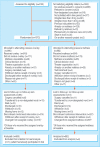Randomised, controlled trial of alternating pressure mattresses compared with alternating pressure overlays for the prevention of pressure ulcers: PRESSURE (pressure relieving support surfaces) trial
- PMID: 16740530
- PMCID: PMC1479673
- DOI: 10.1136/bmj.38849.478299.7C
Randomised, controlled trial of alternating pressure mattresses compared with alternating pressure overlays for the prevention of pressure ulcers: PRESSURE (pressure relieving support surfaces) trial
Erratum in
- BMJ. 2006 Jul 1;333(7557):30
Abstract
Objective: To compare whether differences exist between alternating pressure overlays and alternating pressure mattresses in the development of new pressure ulcers, healing of existing pressure ulcers, and patient acceptability.
Design: Pragmatic, open, multicentre, randomised controlled trial.
Setting: 11 hospitals in six NHS trusts.
Participants: 1972 people admitted to hospital as acute or elective patients.
Interventions: Participants were randomised to an alternating pressure mattress (n = 982) or an alternating pressure overlay (n = 990).
Main outcome measures: The proportion of participants developing a new pressure ulcer of grade 2 or worse; time to development of new pressure ulcers; proportions of participants developing a new ulcer within 30 days; healing of existing pressure ulcers; and patient acceptability.
Results: Intention to treat analysis found no difference in the proportions of participants developing a new pressure ulcer of grade 2 or worse (10.7% overlay patients, 10.3% mattress patients; difference 0.4%, 95% confidence interval--2.3% to 3.1%, P = 0.75). More overlay patients requested change owing to dissatisfaction (23.3%) than mattress patients (18.9%, P = 0.02).
Conclusion: No difference was found between alternating pressure mattresses and alternating pressure overlays in the proportion of people who develop a pressure ulcer.
Trial registration: ISRCTN 78646179.
Comment in
-
Overlays or mattresses to prevent pressure sores?BMJ. 2006 Jun 17;332(7555):1401-2. doi: 10.1136/bmj.332.7555.1401. BMJ. 2006. PMID: 16777859 Free PMC article. No abstract available.
-
Similar proportions of patients developed pressure ulcers on alternating pressure overlays and alternating pressure mattresses.Evid Based Nurs. 2007 Jan;10(1):22. doi: 10.1136/ebn.10.1.22. Evid Based Nurs. 2007. PMID: 17218296 No abstract available.
References
-
- European Pressure Ulcer Advisory Panel. Pressure ulcer treatment guidelines. 1999. www.epuap.org/gltreatment.html (accessed 9 May 2006).
-
- Kaltenhaler E, Whitfield MD, Walters SJ, Akehurst RL, Paisley S. UK, USA and Canada: how do their pressure ulcer prevalence and incidence data compare? J Wound Care 2001;10: 530-5. - PubMed
-
- Nixon J, Thorpe H, Barrow H, Phillips A, Nelson EA, Mason S, et al. Reliability of pressure ulcer classification and diagnosis. J Adv Nurs 2005;50: 613-23. - PubMed
-
- Cullum N, McInnes E, Bell-Syer SE, Legood R. Support surfaces for pressure ulcer prevention. Cochrane Database Syst Rev 2004; CD001735. - PubMed
-
- Bergstrom N, Braden BJ, Laguzza A, Holman V. The Braden scale for predicting pressure sore risk. Nurs Res 1987;36: 205-10. - PubMed
Publication types
MeSH terms
Associated data
Grants and funding
LinkOut - more resources
Full Text Sources
Other Literature Sources
Medical

